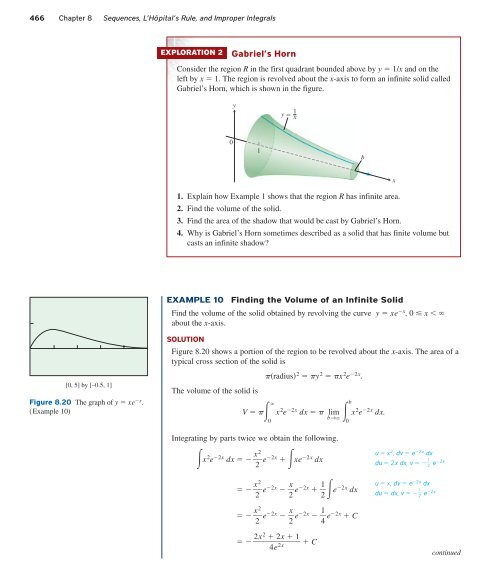You also want an ePaper? Increase the reach of your titles
YUMPU automatically turns print PDFs into web optimized ePapers that Google loves.
466 Chapter 8 Sequences, L’Hôpital’s Rule, and Improper Integrals<br />
EXPLORATION 2<br />
Gabriel’s Horn<br />
Consider the region R in the first quadrant bounded above by y 1/x and on the<br />
left by x 1. The region is revolved about the x-axis to form an infinite solid called<br />
Gabriel’s Horn, which is shown in the figure.<br />
y<br />
y 1 x<br />
0<br />
1<br />
b<br />
1. Explain how Example 1 shows that the region R has infinite area.<br />
2. Find the volume of the solid.<br />
3. Find the area of the shadow that would be cast by Gabriel’s Horn.<br />
4. Why is Gabriel’s Horn sometimes described as a solid that has finite volume but<br />
casts an infinite shadow?<br />
x<br />
EXAMPLE 10<br />
Finding the Volume of an Infinite Solid<br />
Find the volume of the solid obtained by revolving the curve y xe x , 0 x <br />
about the x-axis.<br />
[0, 5] by [–0.5, 1]<br />
Figure 8.20 The graph of y xe x .<br />
(Example 10)<br />
SOLUTION<br />
Figure 8.20 shows a portion of the region to be revolved about the x-axis. The area of a<br />
typical cross section of the solid is<br />
pradius 2 py 2 px 2 e 2x .<br />
The volume of the solid is<br />
V p <br />
0<br />
x 2 e 2x dx p lim<br />
b→ b<br />
0<br />
x 2 e 2x dx.<br />
Integrating by parts twice we obtain the following.<br />
2<br />
x 2 e 2x dx x e<br />
2<br />
2x xe 2x dx<br />
2<br />
x e<br />
2<br />
2x x<br />
e 2x 1 2 2 e 2x dx<br />
u x 2 , dv e 2x dx<br />
du 2x dx, v 2<br />
u x, dv e 2x dx<br />
du dx, v 2<br />
1 e 2x<br />
1 e 2x<br />
2<br />
x e<br />
2<br />
2x x<br />
e 2x 1 2 4 e2x C<br />
2x2 2x<br />
1<br />
<br />
4e2x<br />
C<br />
continued












